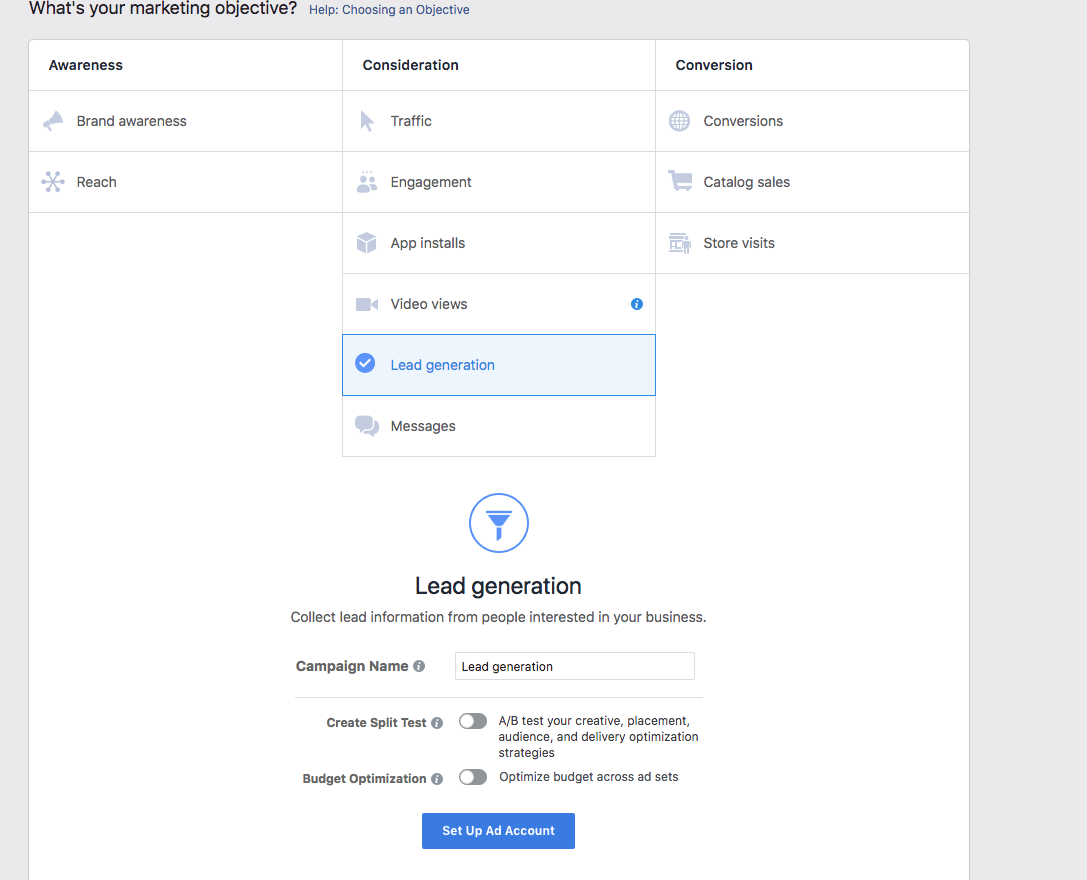Facebook Lead Ads have been around for a few years, but their utility is becoming increasingly important as consumers continue to adopt mobile-optimized solutions.
Facebook Lead Ads solve two specific problems for advertisers:
- Conversions from mobile devices tend to be low.
- Most users don’t use Facebook to shop for products.
Facebook’s lead ads consist of ad copy and a lead form hosted on Facebook or Instagram. The lead form enables advertisers to collect email addresses and other personal information that can be used for remarketing later on.
This case study on the company Ladder found that their cost-per-lead decreased by 80 percent after leveraging lead acquisition in their Facebook ad campaign.
Here, I’d like to share some tips on how my team at LSEO has been able to increase conversions for our clients using Facebook Lead Ads.
1. Running Your Campaign: Cover the Essentials
From initial setup, Facebook allows you to determine the marketing objective of your campaign.


To set up a Lead Ad campaign you’ll need to:
- Upload your company’s privacy policy.
- Fill out a list of questions to ask customers.
- Choose what information you’ll be collecting.
- Define your marketing message.
- Set up targeting for your campaign.
When setting up your Lead Ad campaign keep the following in mind:
- Leverage Lookalike Audiences of your existing customers.
- Set up ‘Appointment Scheduling’ for follow up.
- Use manual bidding for leads of lesser value.
- Add the Facebook Pixel to your website.
- Set up conversion tracking on your website.
- Create separate ads for separate devices.
- Integrate your CRM to capture leads.
- Schedule campaigns to run when customers are most active on Facebook.
These ads will target different customer segments, meaning you should focus on hyper-targeting for your most highly qualified prospects.
Don’t target the same audience group with multiple Lead Ads or else you’ll reduce the exposure of your ads.
2. It All Starts with Targeting
To reduce your CPL and only target your most qualified leads, I recommended targeting Lookalike Audiences of existing customers who have visited your site or interacted with other ads in the past.
This is important because you’re not creating buyer personas of what you might think a shopper would be interested in and potentially wasting your budget.
But it’s important to segment your existing customer base so that you are not targeting unqualified lookalikes or low-value prospects.
Segment by the following boundaries for a more personalized and sharply defined buyer persona:
- Interests.
- Device.
- Location.
- Income.
- Occupation.
There are other psychographic boundaries you might consider targeting depending on your niche. For example, flower delivery services should consider targeting people who are in a new relationship.
Analyze data from people who have converted on other channels, either organically or through remarketing, and use this define what boundaries you wish to target.
- What content and messaging convinced them to make that next jump?
- What demographic data can we gather from these customers?
Lead Ads are interesting because you want to cast a wide net, but you don’t want to come up with an empty catch.
The more people you target, the less powerful your ads become and the higher your costs.
With Lead Ads, you want to target three primary groups:
- Mobile users
- Lookalike Audiences
- Previous website visitors
3. Create a Value-Laden Offer
Now it’s time to choose your unique offer or sales proposition.
- What need are you filling?
- Why is your solution unique?
- What are you giving back to your customers?
If somebody is giving you personal information, you need to offer them something back in return as an incentive.
This can include a number of different options, including:
- A monthly newsletter service
- Free insurance quote
- Coupons or discounts on products or services
- Pre-orders
- Free samples or demos
If your business is using lead acquisition as its primary marketing objective then you’re more likely targeting top- or mid-funnel visitors to create awareness or an initial point of contact with a potential prospect. This means that your ad copy should be more informative than cater to strict shopping intent.
One you have established one or more offers, you need to advertise your value to prospects to help them get past their skepticism.
For B2C businesses, coupons and discounts often work the best.
Some other ideas include:
- Limited time offers
- Free demos
- Early access to content
- Weekly or monthly deals and discounts
It’s important that you walk your users through the signup process.
Some users think clicking on your ad is enough to receive a discount or going to your site, but it’s important to specify that they’ll only receive their benefits once they complete the sign-up form.
4. Design Is Tantamount
Most people are primarily visual learners. We retain images at a much faster rate than text.
For this reason, I’ve outlined the following suggestions for stellar Lead Ad copy:
- Ensure images feature brand aesthetic.
- Showcase someone interacting with your products.
- Use focal points and depth of space to put your products into focus.
- Be sure that images are relevant to text and CTAs.
- Consider leveraging short video advertorials for more engagement and clicks.
Facebook-commissioned Research by Nielsen puts the power of video in perspective – 74 percent of an ad campaign’s total value can be earned within the first 10 seconds of a video.
5. Simplify Your Forms
Unfortunately, Facebook recently got rid of its context card, so now it’s only displayed on top of your lead form.
Regardless, use this real estate to craft a short and concise value proposition that will entice someone to complete their lead form signup.
Simply explain what you’re offering and reaffirm why somebody should sign up. You don’t need to leverage power words, you just simply have to showcase your value.
Generally, you want your signup form to be as short and concise as possible. Only ask for pertinent information, such as an email address or/and a phone number.
While you can ask up to 15 questions, the more questions you ask the less likely your earn a conversion.
6. Follow Up
Now for the most important step of the process. Use ‘Appointment Scheduling’ and clear language to let users know when they should expect a followup email or phone call.
Incorporate your CRM or MailChimp account into your ad campaign so that you can collect prospect information for further reach out.
From here, implement remarketing and email campaigns with personalized offers that incentivize further engagement and conversion.
A CRM will also help you cut down on manually fetching information obtained from lead forms.
Conclusion
Facebook Lead Ads are not designed to drive sales, but instead, add targeted prospects to your sales funnel.
Lead Ads are especially beneficial for targeting mobile users on Facebook who don’t have much intent to purchase a product on that platform.
This approach can be more effective than most other campaign objectives for generating new sales targets.
Setting up Lead Ads is incredibly easy and very effective. The next step is using your digital marketing prowess to encourage that jump from prospect to paying customer.
More Facebook Marketing Resources:
- 4 Awesome Features That Can Improve Your Facebook Ads
- The 3 Facebook Ad Metrics You Aren’t Looking At, But Should Be
- 4 Powerful Facebook Ads Targeting Options
Image Credits
Featured Image: PxHere
All screenshots taken by author, September 2018





![AI Overviews: We Reverse-Engineered Them So You Don't Have To [+ What You Need To Do Next]](https://www.searchenginejournal.com/wp-content/uploads/2025/04/sidebar1x-455.png)